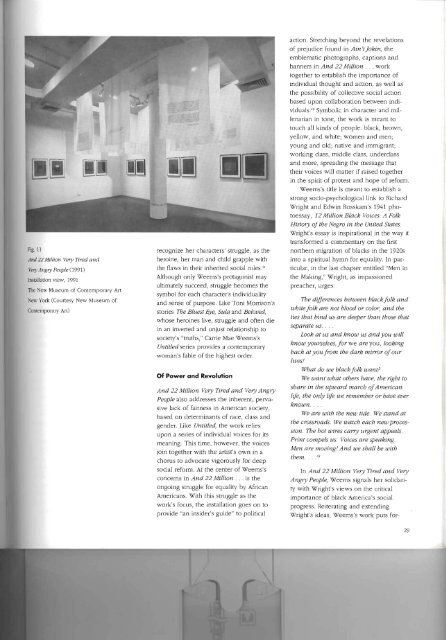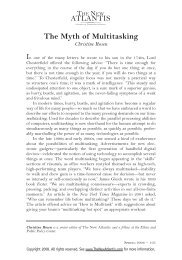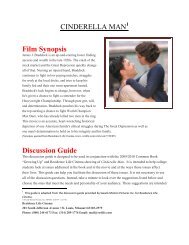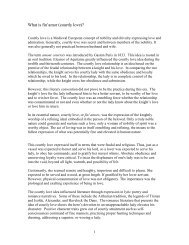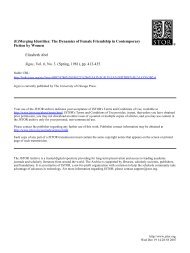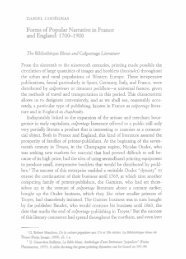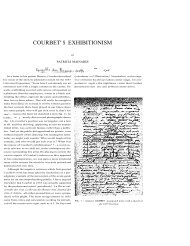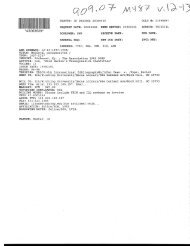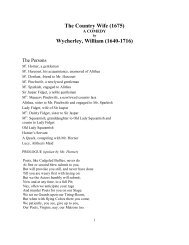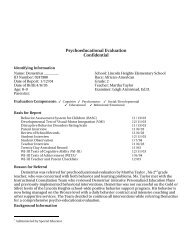CARRIE MAE WEEMS - People Search Directory
CARRIE MAE WEEMS - People Search Directory
CARRIE MAE WEEMS - People Search Directory
Create successful ePaper yourself
Turn your PDF publications into a flip-book with our unique Google optimized e-Paper software.
II II<br />
Fig. 11<br />
And 22 MiLLion Very Tired and<br />
Vel)' Angry <strong>People</strong> (991)<br />
Installation view, 1991<br />
The New Museum of Contemporary Art<br />
New York (Courtesy New Museum of<br />
Conremporaly Art)<br />
recognize her characters' struggle, as the<br />
heroine, her man and child grapple with<br />
the flaws in their inherited social roles."<br />
Although only Weems's protagonist may<br />
ultimately succeed, struggle becomes the<br />
symbol for each character's individuality<br />
and sense of purpose. Like Toni Morrison's<br />
stories The Bluest Eye, Sula and Beloved,<br />
whose heroines live, struggle and often die<br />
in an inverted and unjust relationship to<br />
society's "truths," Carrie Mae Weems's<br />
Untitled series provides a contemporary<br />
woman's fable of the highest order.<br />
Of Power and Revolution<br />
And 22 Million Very Tired and Very Angry<br />
<strong>People</strong> also addresses the inherent, pervasive<br />
lack of fairness in American society,<br />
based on determinants of race, class and<br />
gender. Like Untitled, the work relies<br />
upon a series of individual voices for its<br />
meaning. This time, however, the voices<br />
join together with the artist's own in a<br />
chorus to advocate vigorously for deep<br />
social reform. At the center of Weems's<br />
concerns in And 22 Million . .. is the<br />
ongoing struggle for equality by African<br />
Americans. With this struggle as the<br />
work's focus, the installation goes on to<br />
provide "an insider's guide" to political<br />
action. Stretching beyond the revelations<br />
of prejudice found in Ain'tjokin, the<br />
emblematic photographs, captions and<br />
banners in And 22 Million. . work<br />
together to establish the importance of<br />
individual thought and action, as well as<br />
the possibility of collective social action<br />
based upon collaboration between individuals."<br />
Symbolic in character and millenarian<br />
in tone, the work is meant to<br />
touch aU kinds of people: black, brown,<br />
yellow, and white; women and men;<br />
young and old; native and immigrant;<br />
working class, middle class, underclass<br />
and more, spreading the message that<br />
their voices will matter if raised together<br />
in the spirit of protest and hope of reform.<br />
Weems's title is meant to establish a<br />
strong socio-psychological link to Richard<br />
Wright and Edwin Rosskam's 1941 photoessay,<br />
12 Million Black Voices. A Folk<br />
History ofthe Negro in the United States.<br />
Wright's essay is inspirational in the way it<br />
transformed a commentary on the first<br />
northern migration of blacks in the 1920s<br />
into a spiritual hymn for equality. In particular,<br />
in the last chapter entitled "Men in<br />
the Making," Wright, as impassioned<br />
preacher, urges:<br />
The differences between blackfolk and<br />
white folk are not blood or color, and the<br />
ties that bind us are deeper than those that<br />
separate us.<br />
Look at us and know us and you will<br />
know yourselves, for we are you, looking<br />
back at you from the dark mirror ofour<br />
lives!<br />
What do we blackfolk want?<br />
We want what others have, the right to<br />
share in the upward march ofAmerican<br />
life, the only life we remember or have ever<br />
known.<br />
We are with the new tide. We stand at<br />
the crossroads. We watch each new procession.<br />
The hot wires carry urgent appeals.<br />
Print compels us. Voices are speaking.<br />
Men are moving! And we shall be with<br />
them. 43<br />
In And 22 Million Very Tired and Very<br />
Angry <strong>People</strong>, Weems signals her solidarity<br />
with Wright's views on the critical<br />
importance of black America's social<br />
progress. Reiterating and extending<br />
Wright's ideas, Weems's work puts for<br />
29


